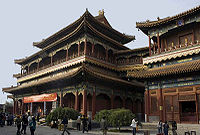Views
(Created page with '{{Temple_infobox |current name=Yǒnghé gōng 雍和宮 |location=Běijīng 北京, Dōngchéng District 東城區, on the east side of Yǒnghé Street 雍和大街 |alternat…') |
m |
||
| (One intermediate revision not shown) | |||
| Line 5: | Line 5: | ||
* | * | ||
|image=[[File:Yonghe_gong.jpg|200px|thumb|center|Yǒnghé Temple]] | |image=[[File:Yonghe_gong.jpg|200px|thumb|center|Yǒnghé Temple]] | ||
| - | |founded= | + | |founded=1723 (Yǒngzhèng 雍正 1) |
|lineage= | |lineage= | ||
|status=Public (十方叢林) | |status=Public (十方叢林) | ||
| Line 11: | Line 11: | ||
}} | }} | ||
| - | '''Yǒnghé gōng 雍和宮''' is the largest Tibetan Buddhist monastery in | + | '''Yǒnghé gōng 雍和宮''' is the largest Tibetan Buddhist monastery in Běijīng and one the most important such monasteries in Hán 漢 China. |
==History== | ==History== | ||
| + | The site that would later be home to Yǒnghé Temple was first established during the Míng 明 Dynasty as living and working quarters for some of the court's tens of thousands of eunuchs. In 1694 (Kāngxī 康熙 33) the Kāngxī 康熙 Emperor used it for the construction of quarters for his fourth son, Yìnzhēn 胤禛 (the future Yǒngzhèng 雍正 Emperor). After ascending to the throne in 1723, Yǒngzhèng turned half of his former residence into a temple. That temple was officially named Yǒnghé gōng 雍和宮 in 1725 (Yǒngzhèng 雍正 3). In the Guāngxù 光緒 Era (1875-1908), this temple served as an administrative center for Tibetan and Mongolian Buddhism in Qīng-controlled territory. | ||
| + | This temple and its residents played a significant role in the dissemination of Tibetan Buddhism among non-Tibetan Chinese during the 1920s. Gōng Xuéguāng 龔學光 (later ordained Nénghǎi [[能海]]), who was an important Hàn proponent of Tibetan Buddhism, studied at this temple in the late 1910s and early 1920s. In [[1925]], the Panchen Lama [[班禪]] made Bái Pǔrén [[白普仁]] the abbot of this temple. Bái taught Tibetan esoteric Buddhism [[西密]] to the monk Dàyǒng [[大勇]], who had previously trained in Japanese esoteric Buddhism [[東密]]. This led Dàyǒng to abandon Japanese esotericism in favor of Tibetan Buddhism and to form the very short-lived Buddhist Tibetan Language College [[藏文學院]]. He eventually led the Hàn students of this school to study Buddhism in Tibet in a group known as the Residing-in-Tibet Dharma Studies Group [[留藏學法團]]. | ||
| + | |||
| + | The temple was renovated by the government in 1950, 1952, and 1979. | ||
| + | |||
| + | Because of the various uses it served during its first several centuries of existence, the temple displays both governmental and religious, and both Hàn and Tibetan architectural styles. The yellow tiles on its roof reflect both its use as an imperial residence, and its position as headquarters for Tibetan Buddhism under the Qīng 清. The temple currently occupies 66,400 square meters of space. | ||
==Personnel== | ==Personnel== | ||
===Important Abbots=== | ===Important Abbots=== | ||
| - | * | + | * Bái Pǔrén [[白普仁]] ([[1925]] - [[1927]]) |
===Notable Residents=== | ===Notable Residents=== | ||
| - | * | + | * Panchen Lama [[班禪]] |
==Temple Institution== | ==Temple Institution== | ||
Current revision as of 22:14, 4 June 2010
Yǒnghé gōng 雍和宮
|
|
|
|
Yǒnghé gōng 雍和宮 is the largest Tibetan Buddhist monastery in Běijīng and one the most important such monasteries in Hán 漢 China.
Contents |
History
The site that would later be home to Yǒnghé Temple was first established during the Míng 明 Dynasty as living and working quarters for some of the court's tens of thousands of eunuchs. In 1694 (Kāngxī 康熙 33) the Kāngxī 康熙 Emperor used it for the construction of quarters for his fourth son, Yìnzhēn 胤禛 (the future Yǒngzhèng 雍正 Emperor). After ascending to the throne in 1723, Yǒngzhèng turned half of his former residence into a temple. That temple was officially named Yǒnghé gōng 雍和宮 in 1725 (Yǒngzhèng 雍正 3). In the Guāngxù 光緒 Era (1875-1908), this temple served as an administrative center for Tibetan and Mongolian Buddhism in Qīng-controlled territory.
This temple and its residents played a significant role in the dissemination of Tibetan Buddhism among non-Tibetan Chinese during the 1920s. Gōng Xuéguāng 龔學光 (later ordained Nénghǎi 能海), who was an important Hàn proponent of Tibetan Buddhism, studied at this temple in the late 1910s and early 1920s. In 1925, the Panchen Lama 班禪 made Bái Pǔrén 白普仁 the abbot of this temple. Bái taught Tibetan esoteric Buddhism 西密 to the monk Dàyǒng 大勇, who had previously trained in Japanese esoteric Buddhism 東密. This led Dàyǒng to abandon Japanese esotericism in favor of Tibetan Buddhism and to form the very short-lived Buddhist Tibetan Language College 藏文學院. He eventually led the Hàn students of this school to study Buddhism in Tibet in a group known as the Residing-in-Tibet Dharma Studies Group 留藏學法團.
The temple was renovated by the government in 1950, 1952, and 1979.
Because of the various uses it served during its first several centuries of existence, the temple displays both governmental and religious, and both Hàn and Tibetan architectural styles. The yellow tiles on its roof reflect both its use as an imperial residence, and its position as headquarters for Tibetan Buddhism under the Qīng 清. The temple currently occupies 66,400 square meters of space.
Personnel
Important Abbots
Notable Residents
- Panchen Lama 班禪
Temple Institution
Important Buildings or Artifacts
Associated Organizations and Groups
Notes
